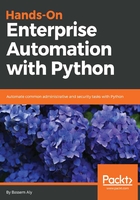
上QQ阅读APP看书,第一时间看更新
The future of network automation
For a long period of time, network automation only meant developing a script using a programming language such as Perl, TcL, or Python in order to execute tasks on different network platforms. This approach is known as script-driven network automation. But as the network becomes more complex and more service-oriented, new types of automation were required and started to appear, such as the following:
- Software-defined network automation: Network devices will have only a forwarding plane, while the control plane is implemented and created using an external software called an SDN controller. The benefit of this approach is there will be a single point of contact for any network changes and the SDN controller can accept those change requests from other software, such as an external portal, through well-implemented northbound interfaces.
- High-level orchestration: This approach requires software called an orchestrator that integrates with SDN controllers and enables the creation of network service models using languages, such as YANG, that abstract the service from the underlying devices that will run over it. Also, an orchestrator can integrate with a Virtual Infrastructure Manager (VIM) such as OpenStack and vCenter, in order to manage virtual machines as a part of network service modeling.
- Policy-based networking: In this type of automation, you describe what you want to have in the network and the system has all the details to figure out how to implement it in the underlying devices. This allows software engineers and developers to implement changes in the network and describe their application's needs in declarative policies.